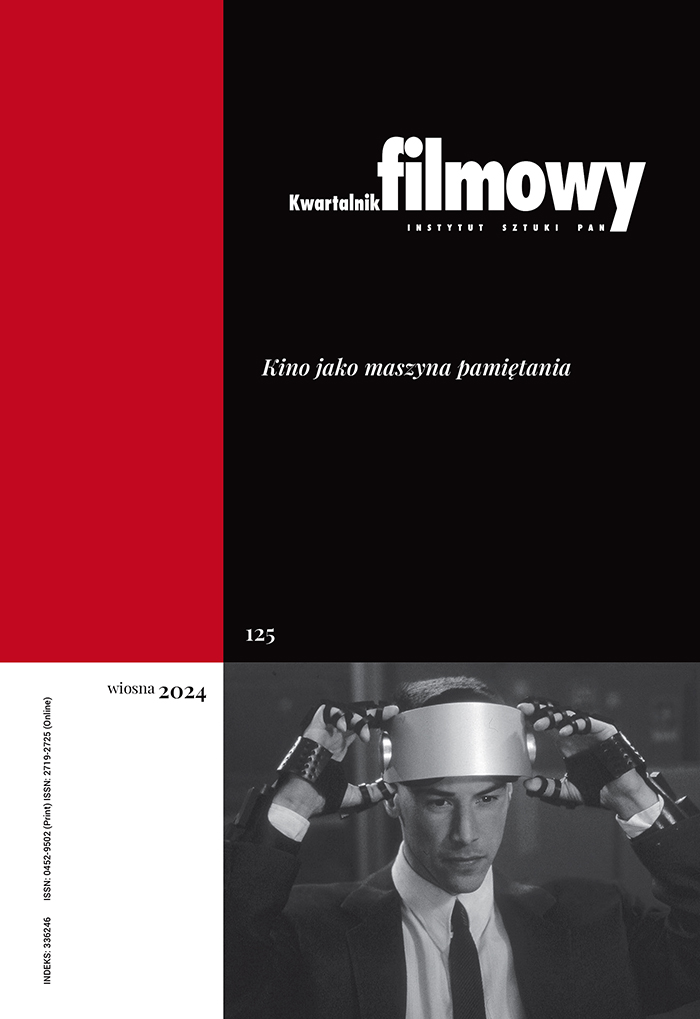“In Short, I Wanted to Get off the Plinth”: Filip Bajon’s “Poznań 56”
Abstract
In the article the author tries to go beyond the usual interpretation of Bajon’s film as a “truth and reconciliation” movie with a child protagonist (which is also how the following films are interpreted: Robert Gliński’s Sunday Frolics, Wojciech Marczewski’s Shivers, and Krzysztof Zanussi’s Gallop). According to the author the child in Poznań 56 is “merely” an element of a strategy, best explained by the words of the director: In short, I wanted to get off the plinth. Bajon’s strategy of demythologization became a cause of the author’s intentions failing to meet social expectations (a need of consolation and factography). Korczarowska-Różycka searches for traces of this misalignment in reviews accompanying the first screenings of the film. An important interpretive context for Bajon’s film is the tradition of so called anniversary film formed in the inter-war period. According to the author, Bajon implements the strategy of fight against patriotic and religious kitsch typical of anniversary films largely by the use of formal solutions unusual for this type of film. One can assume that Brechtian formal elements (such as formal citations and “inner screens”) present in Poznań 56, are means of signalling one’s distance towards history and its representation in film. According to the author the perfect example of Bajon’s attitude towards the past is presented by the use of the formula of “photographic palimpsest”. Poznań 56 is not the expected report on the June events, but a report from the reading of the “traces” left behind by the events in culture, especially in the iconic culture.
Keywords:
Filip Bajon, child, demythologisationReferences
Barthes Roland, Mitologie, tłum. A. Dziadek, Wydawnictwo KR, Warszawa 2000, s. 197.
Google Scholar
Belting Hans, Antropologia obrazu, tłum. M. Bryl, Universitas, Kraków 2007, s. 260-261.
Google Scholar
Braniecki Włodzimierz, Szczun. Z Filipem Bajonem o Poznaniu, o jego wielkopolskiej trylogii filmowej rozmowy prawie o wszystkim, Wydawnictwo „W drodze”, Poznań 1998, s. , 9,13, 13-14, 104, 115,124, 128-129, 133, 134,136, 138,141,145, 147,149-150.
Google Scholar
Codogni Paulina, Rok 1956, Wydawnictwo Prószyński i S-ka, Warszawa 2006, s. 192, 197, 208, 214, 236-236,.
Google Scholar
Deleuze Gilles, Kino, tłum. J. Margański, słowo/obraz terytoria: Gdańsk 2008, s. 108, 235, 277.
Google Scholar
Jankun- Dopartowa Mariola, Gorzkie kino Agnieszki Holland, słowo obraz/terytoria: Gdańsk 2000, s. 193-200.
Google Scholar
Kisielewski Tadeusz, Październik 1956. Punkt odniesienia, Wydawnictwo NERITON, Warszawa 2001, s. 54.
Google Scholar
Kornatowska Maria, Wodzireje i amatorzy, W. A. i F., Warszawa 1990, s. 222
Google Scholar
Kula Marcin, Ku jakiej syntezie polskiego Października? ,w: Historia moja miłość (z zastrzeżeniami), Wydawnictwo UMCS, Lublin 2005, s. 228, 235-236.
Google Scholar
Kundera Milan, Nieznośna lekkość bytu, tłum. A. Holland, PIW: Warszawa 1992, s. 75, 191, 208.
Google Scholar
Lejeune Philippe, Wariacje na temat pewnego paktu. O autobiografii, Universitas: Kraków 2001, s. 34, 54.
Google Scholar
Machcewicz Paweł, Historia nie ożyła, „Polityka” 1997, nr 6, s. 56.
Google Scholar
Madej Alina, Mitologie i konwencje, Universitas, Kraków 1994, s. 140.
Google Scholar
Makowski Edmund, Poznański czerwiec 1956. Pierwszy bunt społeczeństwa PRL, Wydawnictwo Poznańskie, Poznań 2006, s. 25, 63-64, 66, 84-85, 98, 99,105, 108,109, 116,128, 138,163, 209-214, 220, 262, 301.
Google Scholar
Nurczyńska-Fidelska Ewelina, Czas i przesłona. O Filipie Bajonie i jego twórczości, Rabid, Kraków 2003, s. 78, 186,191, 197.
Google Scholar
Nurczyńska-Fidelska Ewelina, Polska klasyka literacka według Andrzeja Wajdy, Wydawnictwo Uniwersytetu Łódzkiego, Łódź 2010, s. 42.
Google Scholar
Przylipiak Mirosław, Poetyka kina dokumentalnego, Wydawnictwo Uniwersytetu Gdańskiego, Gdańsk-Słupsk 2004, s. 60.
Google Scholar
Rouillé Andre, Fotografia, tłum. O. Hedemann, Universitas, Kraków 2007, s. 25, 116-117, 443.
Google Scholar
Sobolewski Tadeusz, Wszystko osobno, „Gazeta Wyborcza” 1997, nr 12, s.12.
Google Scholar
Sontag Susan, O fotografii, tłum. S. Magala, W. A. i F., Warszawa 1986, s. 12,25.
Google Scholar
Soulages François, Estetyka fotografii, tłum. B. Mytych-Forajter i W. Forajter, Universitas, Kraków 2007, s. 7.
Google Scholar
Wróblewski Janusz, Krajobraz po bitwie, „Kino” 1997, nr 1, s. 21.
Google Scholar
Authors
Natasza Korczarowska-Różyckakwartalnik.filmowy@ispan.pl
University of Lodz Poland
Adiunkt w Instytucie Kultury Współczesnej UŁ. Autorka książki Ojczyzny prywatne poświęconej twórczości Tadeusza Konwickiego, Jana Jakuba Kolskiego i Andrzeja Kondratiuka. Specjalizuje się w historii filmu polskiego. Opiekun naukowy i wykładowca Akademii Polskiego Filmu - projektu edukacyjnego Polskiego Instytutu Sztuki Filmowej.
Statistics
Abstract views: 197PDF downloads: 135
License
Copyright (c) 2012 Natasza Korczarowska-Różycka

This work is licensed under a Creative Commons Attribution 4.0 International License.
The author grants the publisher a royalty-free non-exclusive licence (CC BY 4.0) to use the article in Kwartalnik Filmowy, retains full copyright, and agrees to identify the work as first having been published in Kwartalnik Filmowy should it be published or used again (download licence agreement). The journal is published under the CC BY 4.0 licence. By submitting an article, the author agrees to make it available under this licence.
In issues from 105-106 (2019) to 119 (2022) all articles were published under the CC BY-NC-ND 4.0 licence. During this period the authors granted a royalty-free non-exclusive licence (CC BY-ND 4.0) to use their article in „Kwartalnik Filmowy”, retained full copyright, and agreed to identify the work as first having been published in our journal should it be published or used again.
Most read articles by the same author(s)
- Natasza Korczarowska-Różycka, “There Is No Poland Without the Sahara!”: Michał Waszyński’s “Colonial” Films , Kwartalnik Filmowy: No. 92 (2015): Polish Cinema and Politics
- Natasza Korczarowska-Różycka, “Expressionism is a Game... And Why Not?”: The Expressionistic Experiment in the “Strong Man” by Henryk Szaro , Kwartalnik Filmowy: No. 89-90 (2015): Redefinitions of the Classics











